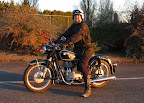It's been a while since I've done serious engine mods - mainly to British singles.
Here's what I did to a Velocette Venom to get plonk, a decent midrange, without losing much if anything of the top end.
Cyl head of the Viper (350cc) for the smaller inlet port. Opened the port up slightly, but concentrated on straightening it and cutting down valve guide intrusion on inlet. Used gaskets to bring the CR down to standard.
Matched the carb to the port and made the induction length 8" if I remember right.
Ground the exhaust valve cam guide follower flat like the Thruxton, but left inlet standard.
Used the heavier flywheels of an MSS but got them balanced by Geoff Dodkin. Polished to a mirror finish - don't think it helped, but looked good

Long megaphone exhaust with narrower taper than usual for the time.
It worked nicely. I lived in the Highlands of Scotland with lots of winding narrow singlelane roads and this gave a bike with great response. The ability to plonk along was invaluable when riding on snow and ice. (Used to ride year round)
Much of this was adapted from the spec of the Velos used for 24 hour races (Montejuich etc)
So left to my own devices, I'd probably do something similar with the BMW, but tricks like modifying cam followers wouldn't work, I'd need to get a cam modified. It would be simpler if one was available off the shelf.
George Ryals wrote:...'69 BSA 441 Victor Special...
I had the motocross version with Ceriani fork. When giving it heaps, sometimes the clutch would be reluctant to disengage, or would slip when the lever was freed even though everything worked perfectly on the bench. I figured the mainshaft was bowing under pressure causing the clutch pushrod to bind, so I cut the clutch pushrod in the centre, case hardened the ends, and put a suitable size ball bearing between the 2 cut parts. This stopped the binding. (You may already know this or don't have the problem)



